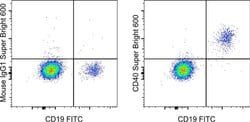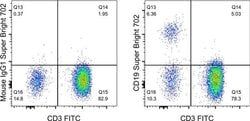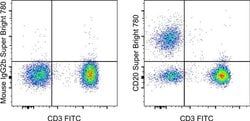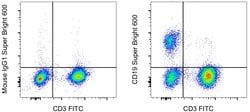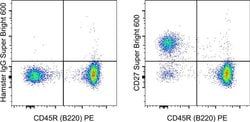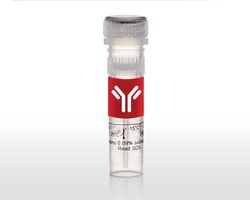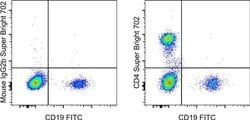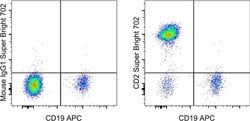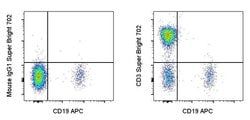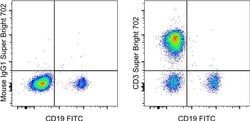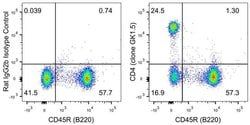CD2 Monoclonal Antibody (RPA-2.10), Super Bright™ 702, eBioscience™, Invitrogen™
Manufacturer: eBioscience
Select a Size
| Pack Size | SKU | Availability | Price |
|---|---|---|---|
| Each of 1 | 67-002-942-Each-of-1 | In Stock | ₹ 33,642.00 |
67-002-942 - Each of 1
In Stock
Quantity
1
Base Price: ₹ 33,642.00
GST (18%): ₹ 6,055.56
Total Price: ₹ 39,697.56
Antigen
CD2
Classification
Monoclonal
Concentration
5 μL/Test
Formulation
PBS with BSA and 0.09% sodium azide; pH 7.2
Gene Accession No.
P06729
Gene Symbols
CD2
Purification Method
Affinity chromatography
Regulatory Status
RUO
Gene ID (Entrez)
914
Content And Storage
4° C, store in dark, DO NOT FREEZE!
Form
Liquid
Applications
Flow Cytometry
Clone
RPA-2.10
Conjugate
Super Bright 702
Gene
CD2
Gene Alias
Cd2; CD2 antigen; CD2 antigen (p50), sheep red blood cell receptor; CD2 molecule; CD2R; cluster of differentiation 2; Erythrocyte receptor; FLJ46032; LFA2; LFA-2; LFA-3 receptor; Ly37; Ly-37; lymphocyte antigen 37; OX34; OX-34; OX-34 antigen; OX-45 surface antigen homolog to human T lymphocyte CD2 antigen; Rosette receptor; SRBC; surface immunoglobulin superfamily molecule; T11; T-cell surface antigen CD2; T-cell surface antigen T11/Leu-5
Host Species
Mouse
Quantity
100 Tests
Primary or Secondary
Primary
Target Species
Human, Non-human Primate
Product Type
Antibody
Isotype
IgG1 κ
Description
- Description: The RPA-2.10 monoclonal antibody reacts with human CD2, a 50 kDa cell surface receptor expressed by a majority of thymocytes, all mature T cells and subset of NK cells
- CD2 is a ligand for CD58 in the human and is involved in adhesion and activation of T cells
- RPA-2.10 blocks mixed lymphocyte reaction
- RPA-2.10 crossreacts to non-human primates and pigs
- Applications Reported: This RPA-2.10 antibody has been reported for use in flow cytometric analysis
- Applications Tested: This RPA-2.10 antibody has been pre-diluted and tested by flow cytometric analysis of normal human peripheral blood cells
- This may be used at 5 μL (0.25 μg) per test
- A test is defined as the amount (μg) of antibody that will stain a cell sample in a final volume of 100 μL
- Cell number should be determined empirically but can range from 10^5 to 10^8 cells/test
- Super Bright 702 is a tandem dye that can be excited with the violet laser line (405 nm) and emits at 702 nm
- We recommend using a 710/50 bandpass filter
- Please make sure that your instrument is capable of detecting this fluorochrome
- When using two or more Super Bright dye-conjugated antibodies in a staining panel, it is recommended to use Super Bright Complete Staining Buffer (Product No
- SB-4401) to minimize any non-specific polymer interactions
- Please refer to the datasheet for Super Bright Staining Buffer for more information
- Light sensitivity: This tandem dye is sensitive to photo-induced oxidation
- CD2 (LFA-2) is a monomeric surface antigen (MW range 45-58 kDa) of the human T-lymphocyte lineage that is expressed on all peripheral blood T cells
- CD2 is one of the earliest T-cell markers, being present on more than 95% of thymocytes and it is also found on some natural killer cells, but not on B lymphocytes
- Monoclonal antibodies directed against CD2 inhibit the formation of rosettes with sheep erythrocytes, indicating that CD2 is the erythrocyte receptor or is closely associated with it
- The interaction between CD2 and CD58 stabilizes adhesion between T cells and antigen presenting or target cells
- Relatively low affinity of CD2 to CD58 (as measured in solution) is compensated within the two-dimensional cell-cell interface to provide tight adhesion
- Moreover, T cell activation induces increased CD2 expression and its lateral mobility, making easier contact between CD2 and CD58
- Subsequently, T cell activation causes fixation of CD58-CD2 at sites of cell-cell contact, thereby strengthening intercellular adhesion
- CD2 deficiency reduces intestinal inflammation and helps to control infection
- Diseases associated with CD2 dysfunction include penis squamous cell carcinoma and immune deficiency due to the absence of the thymus.
